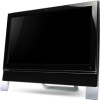Gateway ZX6800 Gateway Desktop Quick Start Guide - Page 19
Internet and Software, Help and Support
 |
View all Gateway ZX6800 manuals
Add to My Manuals
Save this manual to your list of manuals |
Page 19 highlights
Note: If you have an Internet connection, the Guide (Electronic Program Guide) allows you to view a list of current TV shows. This shows channel and network information, as well as the title, description and scheduled broadcast time of shows. Cyberlink PowerDVD If your computer is equipped with a Blu-ray drive, you may watch Blu-ray movies with PowerDVD. You may start PowerDVD by inserting a Blu-ray disc and waiting for the program to start automatically. AutoPlay The Windows AutoPlay function allows you to choose the way Windows handles media files on devices with removable storage (digital camera, CD, DVD, etc). If you have inserted a disk that contains files (such as a DVD, USB key or memory card), Windows will display a dialog box and ask you to choose how you want to open the files. For example, if you have inserted an audio CD or a DVD movie, Windows will automatically display a dialog box and ask you to choose how you want to play it. If Windows asks you to select a DVD player, we recommend that you always choose the DVD player included with your software collection (e.g. PowerDVD or Windows Media Player). Playing downloaded files Downloaded files may work with the media programs installed on your computer, or may require specific programs. Files that include DRM functions may only play in specific programs (e.g. iTunes, Windows Media Player) or only on devices certified for use with the each type of file. Other formats may require a specific audio or video codec that may not have been installed on your computer. Codecs A codec is software that is used to compress or decompress a digital media file, such as a song or video. Windows Media Player and other programs use codecs to play and create digital media files. For example, when you rip a song from an audio CD to your computer, the player uses the Windows Media Audio codec to compress the song into a compact WMA file. When you play that WMA file (or any WMA file that might be streamed from a Web site), the media player uses the Windows Media Audio codec to decompress the file so the music can be played through your speakers. Why do I get a message that says my computer is missing a codec? If you get a message that says that your computer is missing a codec, it may be because you are using a file that was compressed using a codec that Windows or the media player does not include by default. In many cases, you can download and install the missing codec by clicking on the Web Help button in the error message. Please also see Windows Help and Support for more information. Internet and Software - 19















